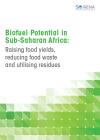

-
-
IRENA (2017), Biofuel Potential in Sub-Saharan Africa: Raising food yields, reducing food waste and utilising residues, International Renewable Energy Agency, Abu Dhabi.
Copied
/-/media/Files/IRENA/Agency/Publication/2017/Nov/IRENA_Biofuel_potential_sub-Saharan_Africa_2017.pdf
Copied
Biofuel potential in Sub-Saharan Africa: Raising food yields, reducing food waste and utilising residues
Newsletter
Sub-Saharan Africa possesses considerable resources to produce sustainable liquid biofuels, based on biomass feedstocks that would neither conflict with food supplies nor add to carbon dioxide emissions. Fulfilling the region’s biofuel potential would depend on increased residue collection from food crops and forest products, as well as intensified cultivation of farmland – beyond food needs – and reducing waste and losses in the food chain.
Biofuel potential in sub-Saharan Africa offers detailed estimates of the biomass resource potential in Ghana, Mozambique, Nigeria, South Africa and Uganda. With conversion to advanced liquid biofuels, sustainable biomass feedstock could potentially meet or exceed the five countries’ combined fuel needs for transport in 2050, according to assessments by the bioenergy team at the International Renewable Energy Agency (IRENA). A variety of policies and measures could help sub-Saharan Africa to realise its biofuel potential. Farm and forest residue collection could be improved by sharing best practices on cost-effective logistical approaches. Agricultural yields could be improved through extension services to spread modern farming techniques and agro-forestry approaches, with a view to cultivating a mix of high-yielding food and fuel crops. Losses and waste in the food chain could be reduced through better harvesting techniques, the availability of storage and cooling facilities, and improved transport. Together, such measures could free substantial amounts of land for crops to produce biofuel.
These assessments build on statistics from the United Nations Food and Agricultural Organization (FAO).




